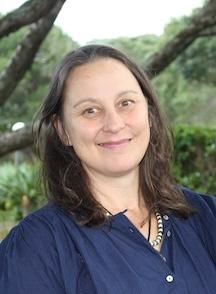
When the new oncology centre at Whangārei Hospital opens in 2026, over 40 metres of photographic panels will grace its walls. The panels depict the rongoā of Tāne-mahuta and are created using the trees, light, and manu of Pukenui Forest—a ngahere that wraps around the western hills of Whangārei, situated close to the hospital. The images come from the tūpuna whenua of artist Nova Paul (Ngāpuhi, Ngāti Hine), who drew on te taiao to guide and create her significant commission.
“When you are vulnerable, you need to draw on the rongoā of Tāne-mahuta—the wairua and mauri of the ngahere. My intention was for people who are māuiui to feel they had a direct connection to the rākau that are on their doorstep, to support them through the cancer treatment journey,” says Nova.
The installation is the culmination of many years of work, including PhD research supported by NPM, exploring the healing power of trees through image-making. Nova is an established filmmaker and artist whose work has been shown both locally and internationally. In 2023, her short film ‘Hawaiki’ was chosen from 10,000 global submissions for the prestigious Sundance Film Festival in the USA.
“For me, making work that supports our people’s healing can be rongoā for them—that is truly what my work is all about. That is mana motuhake and it is essential to my art practice,” she says.
Capturing the mauri — the aura of light radiating from ngā rākau — is central to her image-making. Her research and mātauranga are gathered from years of deep observation of the ngahere, experimenting with light, and in wānanga with pūkenga (experts) as well as her whānau. For this project, Nova was guided by Te Tai Tokerau tohunga, Tohe Ashby, who led a group of rongoā kaimahi [healing practitioners] into Pukenui. They all contributed to elevating the mauri and harnessing the wairua in this kaupapa, she says.
Nova’s filmmaking practice is anchored in early-cinema, 19th-century film making techniques, which often have a material quality due to the analog handmade processes used. Her experimental film practice led her to create a developing emulsion from rākau wai [tree water], sourced from the very trees she filmed. In the darkroom, Nova crafted a consistent methodology to hand-process the film, achieving high-quality outcomes. It was labour intensive research, with film often taking 4–8 hours of developing time for an image to appear in the plant-based developer.
Not only is the plant-based method more environmentally sound, Nova believes it establishes a unique relationship between the viewer and the tree. “We live in a very image-saturated world, but images of trees are not ordinary things. Trees are our tūpuna and our rangatira,” she says.
Nova says that using tree leaves as a developer is an aesthetic way to convey our whanaungatanga connections with the rākau. She hopes her images reflect the tapu [sacredness] of the relationship between people and nature. The ngahere has always had a potent influence in Nova’s life, and she has first-hand experience of its restorative powers in times of anxiety.
“I was encouraged to take te reo total immersion to support my studies and deepen my te ao Māori knowledge, but I really struggled to make headway with pronunciation throughout the entire year-long course. Sometimes I felt like a fraud because I was a teacher in a Māori space. It was humiliating—it felt like I was knocking at a glass door, but I couldn’t walk through,” she says.
After seven months with little headway, Nova sought solace in the bush, where she was able to reach a breakthrough. “I realised my language isn’t verbal. I communicate using images, and that was my strength. Once the penny dropped, it reinforced what I already had — a deep understanding of te taiao and a filmmaking practice. I also understood that Tāne-mahuta has his own language and ways of communicating with us,” she says.
This new awareness lifted the pressure, allowing Nova to embrace learning te reo in a more heart-centred than head-centered way. As a result, her reo learning began to flourish. For Nova, this experience epitomises the power of te taiao.
“Art is a powerful practice that creates a pathway to experience and know the world in new ways. In my creative practice, I uplift the whenua and ngā tāngata Māori enabling us to see ourselves whole and well, and celebrating our connections to our tūpuna whenua, tūpuna tāngata and people.”